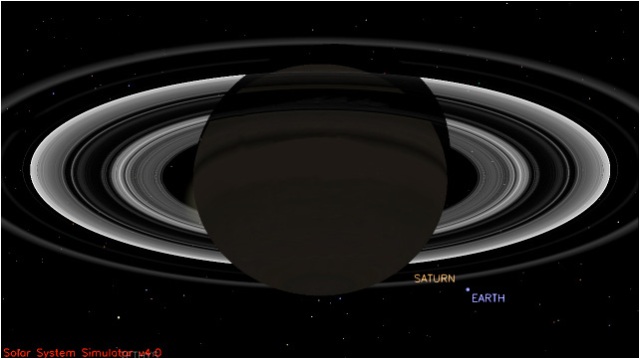Happy Friday! Well would you look at that – we’ve managed to do these updates on time for 3 weeks in a row now! A great improvement over last month, keep up the good work. So what’s going on this week? Well I think I almost have a working spectrometer – that deserved a big cheer! And in the big wide world, outside the walls of my hole lab:
Wave at Saturn!
NASA’s Cassini spacecraft, which is exploring Saturn, is going to take a photo of Earth from 898 million miles or 1.44 billion kilometers away – that’s about 10 times the distance between the Earth and the Sun. We will appear as a small, pale blue dot, about the size of 1 pixel, between Saturn’s ring. Opportunities to photograph the Earth from the outer Solar System don’t come along very often, and its important to take care that the Sun doesn’t blind the cameras. So remember to smile for the camera and Wave at Saturn on the 19th July!

Simulated view from NASA’s Cassini spacecraft shows the expected positions of Saturn and Earth on July 19, 2013, around the time Cassini will take Earth’s picture. Image credit: NASA/JPL-Caltech
Oxygen-rich Martian Atmosphere
4 billion years ago Mar’s atmosphere could have been enriched in oxygen. Here on Earth, our atmosphere did not have high levels of oxygen for at least another 1.5 billion years. Scientists from Oxford University have compared Martian meteorites with data from rocks studied by NASA’s Spirit rover, and say that abundant oxygen early in Mars’ history is the best explanation of the differences they observe between the two. This work, published in Nature this week, could have implications for the possibility of live having existed on Mars in the distant past However, BBC News report that not all scientists agree with the conclusions reached by the Oxford scientists.
European Mission to Mars on track
Another Mars-related story – Europe’s ExoMars mission to the red planet in 2016 is on track after contracts relating to the final stage of construction were signed earlier this week. The ExoMars program, which will search for signatures of Martian life (past or present), is composed of 2 missions:
- An orbiter (plus an entry, descent and landing demonstrator module) to be launched in 2016. As well as looking for evidence of methane and other gases which could be signatures of biological activity, this mission will test key technologies necessary for the 2nd part of the mission.
- A rover scheduled to launch in 2018. The rover will collect samples from the Martian surface and analyse them for signs of life.
Class of 2013 Astronauts
After sifting through over 6000 applications, NASA has selected 8 new trainee astronauts. The group of 4 men and 4 women will start their new jobs at NASA’s Johnson Space Center in Houston later this summer – that’s got to be the best first day in a new job! NASA Administrator Charles Bolden is quoted as saying “They’re excited about the science we’re doing on the International Space Station and our plan to launch from U.S. soil to there on spacecraft built by American companies. And they’re ready to help lead the first human mission to an asteroid and then on to Mars.” Good luck to them all, and please bring us back some good samples from Mars and the asteroids!

